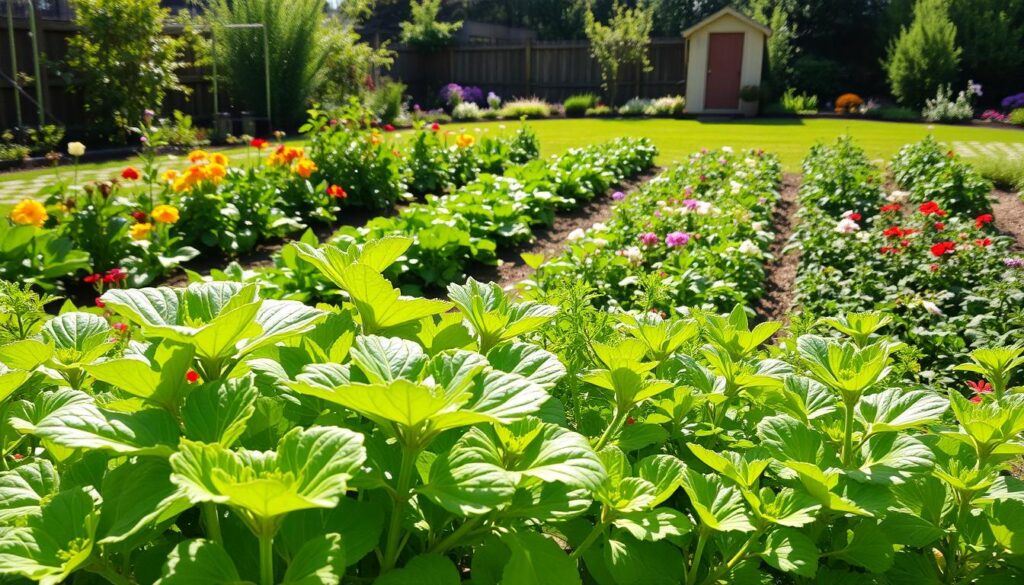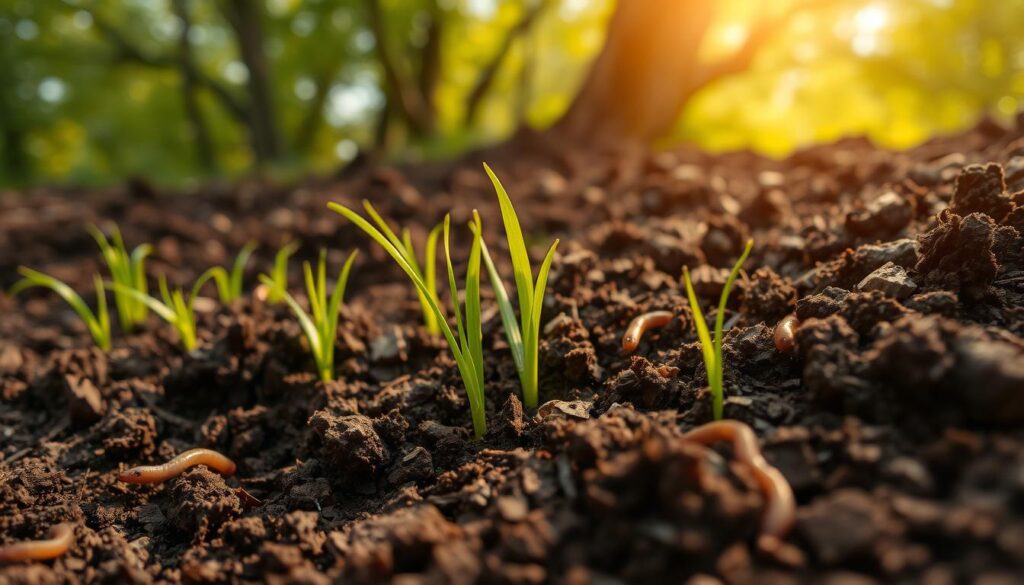Top Gardening Tips for Healthy Plants & Yields

About the Game
Effective gardening tips are key to growing healthy plants and getting a lot of crops. A great garden starts with nutrient-rich soil, smart planning, and steps to stop pests, weeds, and bad weather. People who grow veggies will see better yields and quality by using these methods.
It doesn’t matter if you’re experienced or a beginner. Knowing the basics can make your garden thrive.
Nourish Your Soil for Maximum Growth
Achieving healthy plant growth starts with nourishing the soil. Adding organic matter is key to creating the right conditions for plants. Organic matter, like compost, manure, and leaf mold, boosts nutrient availability and supports strong roots. In winter, this method helps the soil absorb these improvements.
Anúncios
Importance of Organic Matter
Adding organic matter to your garden improves soil health. It makes soil structure better, holds moisture well, and helps beneficial microbes grow. This creates a strong ecosystem that helps plants grow all season. You can make your own nutrient-rich amendment by composting kitchen and yard waste. This eco-friendly step can make your plants and garden flourish.
Effective Winter Preparation Techniques
Preparing soil for winter is crucial. Adding organic matter in the fall lets it break down slowly, enriching the soil for spring. Surface mulching keeps moisture in and weeds out. By doing this, gardeners spend less time on upkeep. They ensure their plants stay healthy and vibrant through changing seasons.
Anúncios

Essential Fertilization Techniques
Choosing the right ways to fertilize can greatly improve your plants’ health and growth. There are many organic fertilizers, each with special benefits for your plants. Using these organic methods helps our planet and makes your garden flourish.
Types of Organic Fertilizers
Organic fertilizers vary, giving gardeners options for their needs. Some popular ones include:
- Composted materials
- Manure from herbivores
- Fish emulsion
- Bone meal
- Seaweed extract
These fertilizers improve soil and give plants key nutrients. For example, products like seaweed concentrate give nutrients that plants quickly absorb. This encourages strong growth.
Homemade Fertilizers: Comfrey Tea and More
Making fertilizers at home saves money and is good for the environment. Comfrey tea is a great choice. It’s packed with nutrients. To make it, soak comfrey leaves in water. This pulls out important vitamins and minerals. Plants like tomatoes, that need lots of nutrients, benefit from comfrey tea all season.
Other homemade fertilizer options include:
- Banana peel fertilizer
- Eggshell powder
- Coffee grounds
Using kitchen leftovers as fertilizers feeds your plants well. It’s a smart recycling move.
Gardening Tips for Better Plant Spacing
Getting your plants spaced right is key for a healthy garden. If plants are too close, they fight for food, water, and light. This can slow their growth and make them sick. Spacing them out means air can flow better. This helps keep fungi away and helps plants grow strong.
Here’s how to use your garden space smartly:
- Check how much room each plant needs before you plant.
- Use a garden planner tool to make the most of your space.
- Put plants with the same sunlight and water needs together for an easier time.
- Try vertical gardening to use space in clever ways.
By following these tips, your garden can grow healthy and strong. Good spacing stops diseases and helps your garden thrive all season long. Remember, spacing is super important for a great garden.
Choosing Plants that Thrive in Your Environment
Successful gardening starts with picking the right plants for your area. It’s important to know your local climate to garden well. Choose plants that fit your area’s weather to help your garden grow strong and produce a lot.
Understanding Your Local Climate
First, get to know your local climate’s features. Knowing your USDA Hardiness Zone is key to picking plants that will do well. These zones show the temperatures and conditions of your area, guiding your plant choices.
Opting for Native and Hardy Varieties
Using native and tough plants in your garden boosts your chances of success. Native plants are used to local conditions and fight off pests better. Hardy plants can deal with big changes in temperature, letting you grow plants that not only live but flourish. Think about adding plants like:
- Echinacea for sunny spots
- Black-eyed Susans for vibrant color
- Serviceberry trees for edible fruit
Choosing these plants improves your garden’s output and supports a healthy environment for both plants and animals.
Utilizing Shade for Increased Productivity
Shade gardening opens doors for growing more in spaces with little sunlight. Many gardeners don’t use these areas well. Yet, they can be turned into productive spots. Using shade wisely allows you to grow a range of plants well.
Plants like spinach and kale do great in shade, needing less sunlight. Peas and some herbs also grow well in these cooler spots. Picking the right plants helps make shaded parts of your garden fruitful.
- Select slow-growing plants that can develop over a longer period.
- Regularly assess the amount of light different sections of your garden receive.
- Incorporate layers, using taller plants to create shelter for smaller ones that prefer indirect light.
- Utilize mulch to retain moisture and maintain soil temperature.
By choosing the right shade-loving plants and caring for them, you can boost your garden’s yield. This way, every part of your space works hard, including the shady spots.
Water Conservation Strategies
Effective water conservation is key to keeping a garden sustainable. Using methods like collecting rainwater not only saves water but also gives plants clean moisture. By learning different watering ways, you can keep your garden healthy and cut down on waste.
Collecting Rainwater Effectively
To make your garden’s watering system better, setting up a rainwater collection is a smart move. Here’s how you can do it right:
- Install rain barrels under downspouts to capture runoff.
- Ensure barrels are covered to prevent mosquito breeding.
- Use a filter to remove debris before water enters the barrels.
- Check local regulations regarding rainwater harvesting.
Best Practices for Watering Your Garden
Using the best watering methods is crucial for keeping your garden thriving. Here are some top tips for watering:
- Water early in the morning or late in the afternoon to reduce evaporation.
- Use deep watering methods to encourage strong root development.
- Avoid overhead watering, which can lead to fungal diseases.
- Monitor soil moisture to prevent over-watering.
Extending the Growing Season
For those who love gardening, frost dates are vital for a great yield. They help you plan when to plant your seeds. This way, you can grow more and have a longer harvest time.
Understanding Frost Dates
Frost dates help you know when cold might hurt your plants. The last frost date in spring tells you when it’s safe for sensitive plants. The first frost date in fall shows when to protect them. This knowledge helps you plant at the best times for a longer growing season.
Using Plant Protection Techniques
Protecting your plants from frost can make your growing season longer. You can:
- Use row covers to keep plants warm.
- Put up cold frames to help seedlings stay warm.
- Add mulch to keep soil temperatures steady.
These methods can keep your plants safe from early or late frosts. They help your garden thrive longer.
Importance of Companion Planting
Companion planting is key to making your garden healthier and more productive. It means putting plants together that help each other grow well. This method uses the garden space well and helps control pests naturally.
Mutually Beneficial Plant Combinations
Mixing different plants can make your garden more lively and helpful for each other. Like:
- Corn and beans: Corn lets beans climb it, and beans make the soil better for both.
- Tomatoes and basil: Basil makes tomatoes taste better and keeps some pests away.
- Carrots and onions: Onions’ strong smell keeps carrot flies away, making carrots grow better.
Pest Control through Companion Planting
Companion planting can also fight pests without needing chemicals. Some plants naturally keep pests away. For example:
- Marigolds: They push away nematodes and draw in helpful insects.
- Garlic: Its strong smell keeps many pests at bay and helps other plants grow better.
- Nasturtiums: They attract aphids away from other important plants.
Conclusion
Gardening success comes from rich soil, right plant choices, and good watering. Adding organic stuff to your soil and picking plants suited for your area helps plants grow well. These steps not only make your plants healthier but also support eco-friendly gardening.
Companion planting is another great tip. It helps keep pests away and uses space and food better. Knowing how plants get along can give you more and better crops. Using these tips is important for a garden full of happy, healthy plants.
Keep these ideas in mind as you garden. It doesn’t matter if you’re experienced or just beginning. Caring for your garden’s environment is key. Stick with these tips for a garden full of beautiful plants and big harvests.
FAQ
What is the best way to enrich my garden soil?
How can I effectively prepare my soil during winter?
What types of organic fertilizers are most beneficial for plants?
How do I space my plants properly for optimal growth?
Why should I choose plants suited to my local climate?
What are the best plants to grow in shaded areas?
How can rainwater collection improve my garden’s irrigation?
How can I extend my gardening season?
What are effective companion planting strategies?
Game Details
No
No